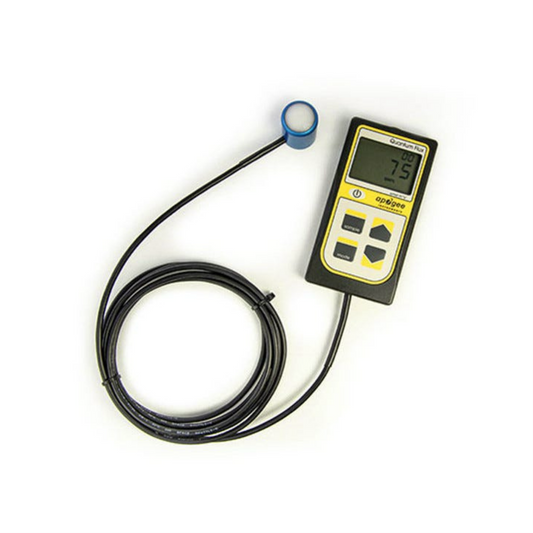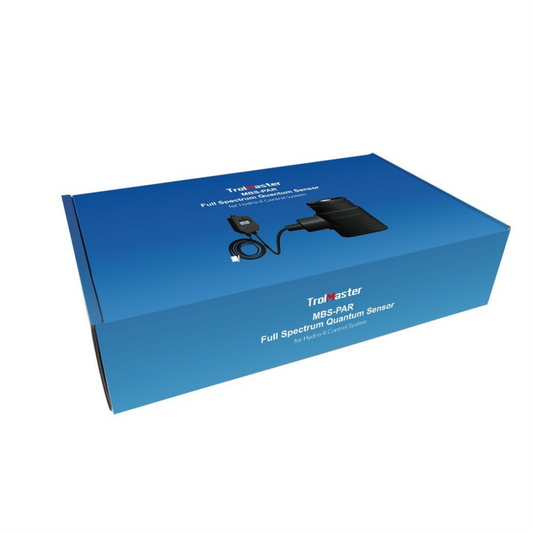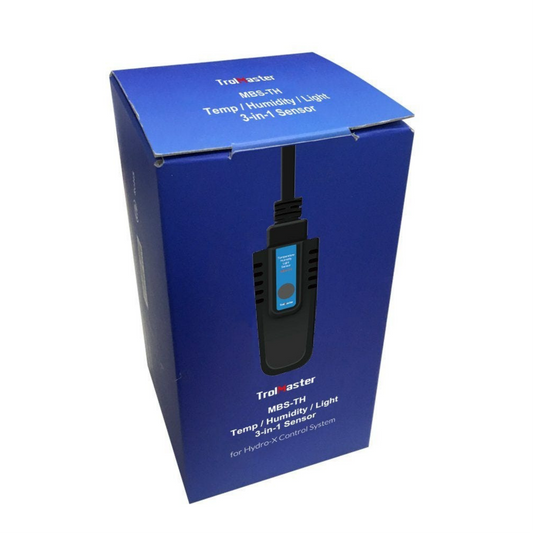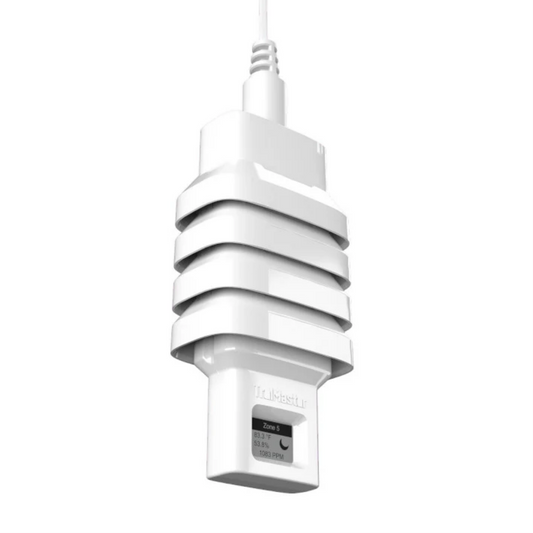Light Meters & PAR Meters
Optimize your grow with Light Meters & PAR Meters that benchmark PPFD, DLI, and uniformity for indoor farms, greenhouses, and vertical racks. Verify true canopy intensity, fine-tune dimming and spacing, and boost yield and quality with data-driven lighting.
-
Apogee PAR PPFD Quantum Meter and Sensor MQ-500
Vendor:Apogee Instruments Inc.Regular price $667.00 USDRegular priceUnit price / per -
PHOTOBIO Advanced Quantum | PAR Light Meter (Micromols)
Vendor:PHOTOBIORegular price $149.94 USDRegular priceUnit price / per -
TrolMaster Full Spectrum Quantum Sensor
Vendor:TrolMasterRegular price $463.84 USDRegular priceUnit price / per$463.84 USDSale price $463.84 USD -
TrolMaster Temp Humidity Light Replacement Sensor for Hydro-X
Vendor:TrolMasterRegular price $78.80 USDRegular priceUnit price / per$78.80 USDSale price $78.80 USD -
TrolMaster Temp/Humid/CO2/Light 4-in-1 Sensor for Hydro-X Pro
Vendor:TrolMasterRegular price $417.95 USDRegular priceUnit price / per$417.95 USDSale price $417.95 USD -
Iluminar HASH Environment Sensor Module (PAR, Temperature, Humidity, CO2)
Vendor:Iluminar LightingRegular price $479.75 USDRegular priceUnit price / per$505.00 USDSale price $479.75 USDSale
Light Meters & PAR Meters
For Indoor Farms, Greenhouses & Vertical Systems
Dial in your lighting with professional Light Meters & PAR Meters engineered for controlled-environment agriculture. These instruments measure photosynthetically active radiation (PAR), PPFD, and illuminance so you can set the correct intensity, confirm uniformity, and optimize DLI—boosting plant vigor, consistency, and yield while reducing energy waste. Whether you run an indoor farm, glasshouse, or vertical rack, accurate light measurement is the fastest way to match crop targets to fixture output and spacing...
Why Use Light & PAR Meters?
Grow lights drift, canopies change height, and rooms develop hotspots. PAR/PPFD meters and lux meters let you verify real PPFD at the canopy, balance fixtures, and hit DLI goals by stage—resulting in tighter internodes, stronger rooting, uniform coloration, and predictable harvest timing. Data-driven lighting also prevents over-lighting (photoinhibition) and under-lighting, saving on kWh and lamp changeouts.
Key Benefits
• Fast PPFD verification for propagation, veg, and flowering
• Confirms uniformity across trays, benches, and tiers
• Optimizes DLI (mol·m⁻²·day⁻¹) to match cultivar/crop recipes
• Reduces heat load, energy spend, and light-related stress
• Supports audit trails and SOPs for compliant production
Primary Uses
• Map PPFD at canopy height and adjust dimming/height
• Calculate DLI by logging PPFD over the photoperiod
• Benchmark new fixtures and validate after maintenance
• Compare spectra/outputs across rooms and seasons
Types of Light & PAR Meters
• Quantum PAR meters (400–700 nm): The industry standard for measuring PPFD in µmol·m⁻²·s⁻¹.
• ePAR meters (380–760 nm): Capture extended wavelengths some crops can utilize.
• Lux/foot-candle light meters: Fast checks for illuminance (not wavelength-weighted for photosynthesis).
• Data-logging & wireless meters: Automate DLI and uniformity studies; export for QA/QC.
• Cosine-corrected sensors: Improve accuracy for angled light in greenhouses and multi-tier racks.
How These Meters Help Growers
By translating fixture output into PPFD and DLI at plant level, meters let you set repeatable light recipes by stage, crop, and season. Expect stronger vegetative growth, dense flowering/fruiting, and consistent quality—without overspending on watts.
Shop Trusted Brands
Explore leading instruments used by commercial growers and researchers:
• Apogee Instruments
• Iluminar Lighting
• Photobio
• TrolMaster

Frequently Asked Questions
What is a PAR meter?
A PAR meter uses a quantum sensor to measure photosynthetically active radiation (400–700 nm) as PPFD in µmol·m⁻²·s⁻¹. It tells you how much usable light your plants receive at the canopy in real time.
What is the difference between a PAR meter and a light meter?
A PAR meter measures wavelength-weighted light for photosynthesis (PPFD, µmol·m⁻²·s⁻¹). A light meter (lux/foot-candle) measures perceived brightness to the human eye and doesn’t weight red/blue the same way plants do—useful for quick checks, but not a substitute for PAR/PPFD.
What is a good PAR value for a grow light?
Targets vary by stage and crop, but common PPFD ranges are: propagation/seedlings ~100–300, vegetative 300–600, and flowering/fruiting 600–900 µmol·m⁻²·s⁻¹. Always pair with DLI goals and crop tolerance.
What is the optimal light intensity for plant growth?
“Optimal” depends on species and stage. As a starting point, aim for DLI ~6–12 for cloning/starts, 12–20 for vegetative herbs/greens, and 20–40+ for fruiting crops. Convert DLI↔PPFD using your photoperiod and measurements.
What is the best PAR for flowering plants?
Many flowering and fruiting crops respond well to ~600–900 µmol·m⁻²·s⁻¹ with a DLI around 30–50 mol·m⁻²·day⁻¹, assuming adequate CO₂, nutrition, and temperature/humidity.
Are PPFD and PAR the same?
No. PAR is the spectral range (what wavelengths “count”). PPFD is the rate of photosynthetic photons landing on a square meter per second within that range.
How to measure light intensity in plants?
Place a PAR sensor at canopy height, take multiple readings across a grid, and average the values to assess uniformity. Log readings over the photoperiod to calculate DLI and adjust dimming/height/spacing accordingly.
What is a good PAR value for a grow light?
For quick reference: 100–300 µmol·m⁻²·s⁻¹ for starts, 300–600 for vegging greens/herbs, 600–900 for flowering/fruiting. Adjust to crop tolerance and CO₂ levels.
What is the ideal ppm for hydroponics?
For nutrient solution (TDS as ppm, 500/700 scale): seedlings/clones ~300–500; vegetative greens/herbs ~800–1200; heavy fruiting crops ~1000–1600. Always confirm with EC, pH, and crop-specific guidelines.










